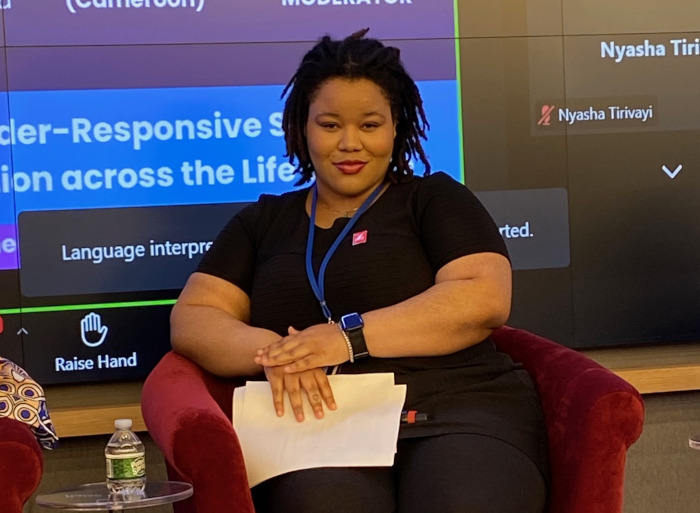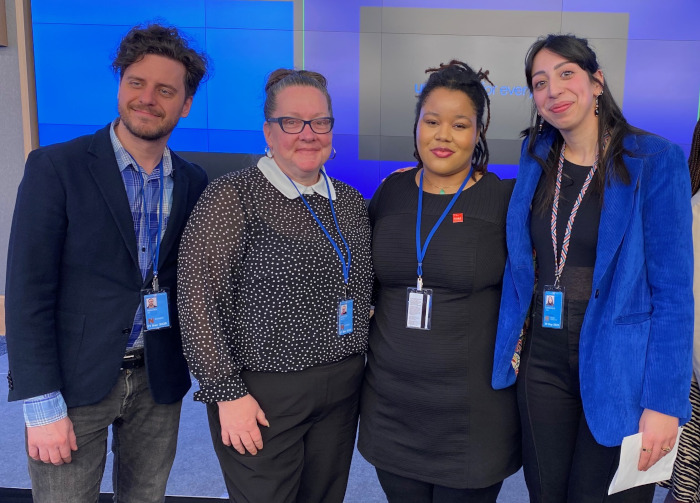“Society and institutions cannot let 51% of the global population ‘fall through the cracks.’”

Above: Kathleen Saint-Amand
As part of the United Nations 69th Commission on the Status of Women, ATD Fourth World USA activist and New York Team intern, Kathleen Saint-Amand took part in the UNICEF side panel, “Years of Her Life: Gender Responsive Social Protection across the Life Course,” on March 13th. As a guest speaker, Kathleen addressed why 26% of children live in poverty in New York City – a higher rate than many regions of the world, why young girls are disproportionately affected by poverty, and what is needed to strengthen social protection for women and girls.
Kathleen’s full statement:
Thank you for the introduction and the opportunity to speak here today.
To understand why 26% of children in New York City live in poverty, we must first acknowledge the root causes of poverty: greed, and the reactive, or even inactive nature of many political structures regarding the social welfare of their citizens. When these elements are addressed, we see significant changes in the wellbeing of women and girls in poverty.
Children are largely affected by poverty in New York City because of the unattainable cost of living and the overall lack of knowledge about, access to, and funding for programs that can keep children out of poverty. These programs often have wage requirements that a family may slightly exceed on paper, but in reality, are still impoverished. The grandiosity associated with New York City and its culture also plays a huge role, as it keeps people from addressing rampant gentrification, rising rent costs, and a lack of opportunities, and dismissing them as the lay of the land, when these factors actually drive poverty.
When you’re born female, you are automatically 3 steps behind in society, and even further if you are a Black girl. Research in the United States has shown that, starting as early as the age of 5, Black children are seen as not needing as much nurturing as their white peers due to implicit bias. In school, Black girls are punished at higher rates and receive harsher punishment than their white peers. Even our hair is called into question and scrutinized. Black women’s physical pain and health issues aren’t taken seriously, which is one of the many factors that cause high maternal and infant mortality rates for Black women today, even within a rich nation like the United States.
Girls are expected to endure shame, pain, fear, hunger, squalor, stress—and come out on the other side as “normal,” well-rounded human beings. We are given this weight to carry as children and are expected to be all-knowing to protect ourselves from the dangers of the world, but denied the ability to speak for ourselves when most critical. Poverty, caused by inadequate, unjust social protection systems, compounds this.
The poverty induced trauma that girls experience in childhood leads to toxic stress, which can affect them throughout their life—always lurking just beneath the surface.
I grew up in poverty, but I was not a child of neglect at all. My mother didn’t fail me as a parent; social protection systems failed her, launching us into poverty.
At 8 years old, I went from sleeping in my own bed to sleeping on the carpeted floor of my aunt’s apartment. I knew that other kids could see that I was going without, and that they would pick on me for it. It’s difficult to relate to your peers when you’ve had to navigate life as an adult. I’ve had to decide on a busy sidewalk, which of my possessions to keep. What to spontaneously throw away, because of a two-bag policy for admission into a homeless shelter.

How could I go back to school and talk about music and movies when my life had just been turned upside down?
We must eradicate poverty to protect girls and women from ever experiencing it. We all have and will face unavoidable difficulties in life, but poverty does not have to be one of them. There is no excuse.
This is why social protection must be gender responsive, conscious of cultural differences, anti-racist, trauma responsive and reductive, and fully inclusive for ALL women and girls. Most importantly, they must be fully funded.
Poverty will continue to be cyclic unless social protection systems are designed to be gender responsive. Society and institutions cannot let 51% of the global population “fall through the cracks.”
We must provide girls and women who have faced poverty extensive resources – (counselors, mentors, legal aid)- and they must be tailored to address the complex nature of poverty.
Rather than accepting false narratives about poverty or victim blaming, we must believe women and girls, especially Black women and girls. If we want a better future, we must make it our mission to heal people.
Finally, we must include the people most affected—women and girls with direct experience of poverty at decision-making tables. Their experiential knowledge is critical in any design, implementation, and review of social protections.
Thank you for your attention.

